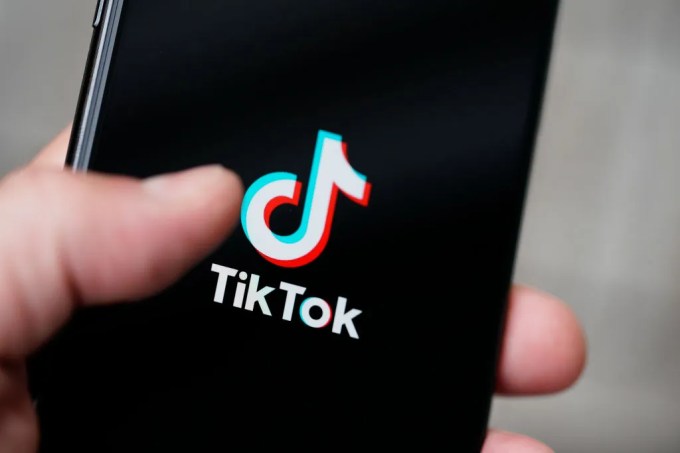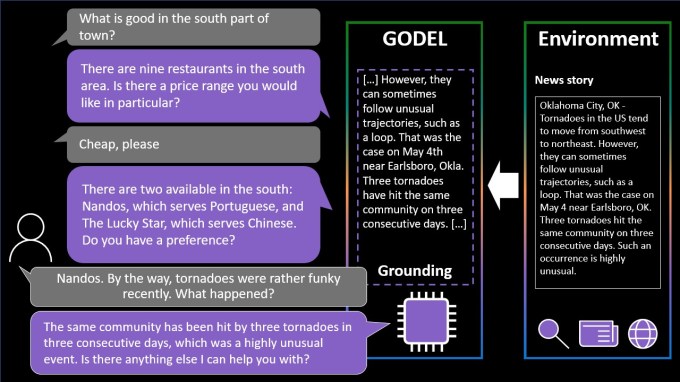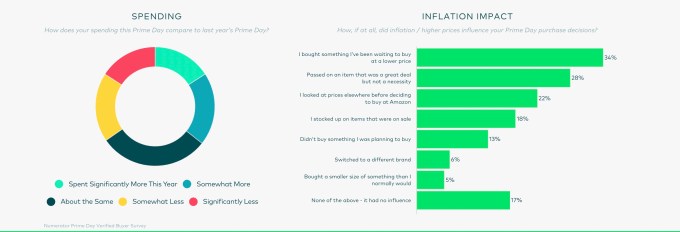Equity drops every Monday at 7 a.m. PDT and Wednesday and Friday at 6 a.m. PDT, so subscribe to us on Apple Podcasts, Overcast, Spotify and all the casts.
Category: TECHNOLOGY
Building the future of robotics
Hello and welcome to a special edition of Equity!
Today, Alex sat down Brian Heater, a long-tenured TechCrunch denizen, our hardware editor, podcast extraordinaire, and genial chap. He also put together a really neat robotics-focused event that we’re hosting next week. The event is online, and free, which means that everyone can come and hang (that means you!)
The confab was also a good excuse to snag time with Heater, and have a bit of a natter about robotics, how the self-driving hardware stack has an impact on more than just automobiles, and why we are going to need AGI for robotics to, you know, become the thing we know from the Jetsons.
In short, robotics is improving rapidly, but we might continue to see more industrial applications than personal for some time. Still, there’s still a lot of activity in the market, including labor policy, e-commerce applications, and a host of other topics.
Enjoy! Equity is back Monday morning, and if you want to come hang at the TC Sessions: Robotics 2022, you can sign up here for free. See you there!
https://techcrunch.com/2022/07/16/building-the-future-of-robotics/
After Roe’s reversal, founders of women’s health startups prepare for battle
Advocates and organizers had been preparing for Roe v. Wade to be overturned since the U.S. Supreme Court draft decision leaked in early May. But Nadya Okamoto, co-founder of period care company August, still felt heartbroken when the decision became official in late June.
“One of the things that always made me passionate about policy and legislative action was that it always felt so permanent,” she told TechCrunch. “For Roe to be rolled back went against many of the beliefs I had about change and social progress.”
Activists like Okamoto are now on the front lines of once again protesting for an individual’s right to an abortion. As a startup founder, Okamoto said she’s ready to use her platform and position to help educate and influence others — and she’s not alone.
Many women founders running reproductive health companies are taking battle stances as the U.S. slips into a reality worse than what existed pre-Roe. Come November, 26 states face a near-total abortion ban.
The decision to reverse Roe also paves the way for the erosion of other rights, such as those that gave the right to interracial and gay marriage.
For this reason, TechCrunch conducted another vibe check, this time with the women founders taking themselves and their companies to the front lines of the fight for abortion. Okamoto and some of the others admit they never thought they would see themselves here; at the same time, it feels as if they’ve been preparing their whole life to take up this fight.
“It’s a privilege to have a platform,” Okamoto said. “That privilege should be reconciled by using said platform to do something important.”
This Week in Apps: Elon wants out, TikTok’s content ratings, a new milestone for subscription revenue
A major shift in the U.S. app economy has just taken place. In the second quarter of this year, U.S. consumer spending in non-game mobile apps surpassed spending in mobile games for the first time in May 2022, and the trend continued in June. This drove the total revenue generated by non-game apps higher for the quarter, reaching about $3.4 billion on the U.S. App Store, compared with $3.3 billion spent on mobile games.
After the shift in May, 50.3% of the spending was coming from non-game apps by June 2022, according to new findings in a report from app intelligence firm Sensor Tower. By comparison, games had accounted for more than two-thirds of total spending on the U.S. App Store just five years ago.
The trend was limited to the U.S. App Store and was not seen on Google Play, however. In Q2, games accounted for $2.3 billion in consumer spending on Google Play in the U.S., while non-game apps accounted for about $1 billion. about the new data here.
Kids and teens now spend more time on TikTok than YouTube

Image Credits: Nur Photo (opens in a new window) / Getty Images
A study of 400,000 families performed by parental control software maker Qustodio found that kids and teens ages 4-18 now spend more time watching videos on TikTok than they do watching YouTube — and that’s been the case since June 2020, in fact. That month, TikTok overtook YouTube for the first time, as this younger demographic began averaging 82 minutes per day on TikTok versus an average of 75 minutes per day on YouTube.
YouTube had still been ahead in 2019 as kids and teens were spending an average of 48 minutes on the platform on a global basis, compared with 38 minutes on TikTok. But with the shift in usage that took place in June 2020, TikTok came out on top for 2020 as a whole, with an average of 75 minutes per day, compared with 64 minutes for YouTube.
In the years since, TikTok has continued to dominate with younger users. By the end of 2021, kids and teens were watching an average of 91 minutes of TikTok per day compared with just 56 minutes per day spent watching YouTube, on a global basis.
Likely aware of this threat, YouTube launched its own short-form platform called Shorts, which it now claims has topped 1.5 billion logged-in monthly users. The company believes this will push users toward its long-form content — but so far, that hasn’t happened, it seems.
Welcome back to This Week in Apps, the weekly TechCrunch series that recaps the latest in mobile OS news, mobile applications and the overall app economy.
Global app spending reached $65 billion in the first half of 2022, up only slightly from the $64.4 billion during the same period in 2021, as hypergrowth fueled by the pandemic has slowed down. But overall, the app economy is continuing to grow, having produced a record number of downloads and consumer spending across both the iOS and Google Play stores combined in 2021, according to the latest year-end reports. Global spending across iOS and Google Play last year was $133 billion, and consumers downloaded 143.6 billion apps.
This Week in Apps offers a way to keep up with this fast-moving industry in one place with the latest from the world of apps, including news, updates, startup fundings, mergers and acquisitions, and much more.
Do you want This Week in Apps in your inbox every Saturday? Sign up heretechcrunch.com/newsletters
Top Stories
TikTok is getting a rating system
Some TikToks are too racy or mature for younger teens — a problem TikTok aims to address with the upcoming launch of a new content ratings system. The “Content Levels” system, as it will be called, is meant to provide a means of classifying content on the video app — similar to how movies, TV shows and video games today feature age ratings.
TikTok acknowledged some content on its app may contain “mature or complex themes that may reflect personal experiences or real-world events that are intended for older audiences.” It will work to assign these sorts of videos a “maturity score” that will block them from being viewed by younger users. Not all videos will be rated, however. The goal will be to rate videos that get flagged for review and those that are gaining virality. Initially, the system will focus on preventing inappropriate content from reaching users ages 13 to 17, TikTok says, but will become a broader system over time.
The launch follows a 2021 congressional inquiry into social apps, including TikTok and others, which focused on how their algorithmic recommendation systems could be promoting harmful content, like eating disorder content, to younger users. TikTok has also been making headlines for its promotion of dangerous and destructive viral stunts, like kids destroying public school bathrooms, shooting each other with pellet guns or jumping off milk crates, among other things.
TikTok, like other social apps, is in hot water over the potential negative impacts to minors using its service. But it’s under particular scrutiny since the reveal that parent company ByteDance — in China — was accessing U.S. TikTok user data. Alongside the maturity ratings, TikTok says it will also launch content filters that will let users block videos with hashtags or certain words from their feeds.
For all its ills, TikTok has more developed parental controls than its …read more
Market dissonance doesn’t always include an easy hot take
Stripe’s internal valuation is cut
Stripe is the latest high-profile fintech company to take a massive valuation cut as the market downturn begins to hit the sector especially hard. Last valued at $95 billion, the payments processor has cut the internal value of its shares by 28%,
Welcome to Startups Weekly, a fresh human-first take on this week’s startup news and trends. To get this in your inbox, subscribe here.
At this point, it’s clear that no one agrees on anything. Half my sources say that early-stage venture completely is uncorrelated to the public stock market, while the other half say that everyone is pivoting their way to profitability to extend runway — regardless of stage. And while the dissonance is an evergreen story to cover, it’s also confusing.
For example, how can there be more VC dry powder than ever, but also a slowdown in investments? How can fintech still receive one out of every five dollars of venture finance, yet still be the sector with the most layoffs of this recent wave? How can LPs be rethinking their venture capital positions, but it also be an optimistic time for emerging fund managers to finally debut? How can Stripe’s adjusted valuation be bullish news of a company ahead of the curve, while also be a decline in what it’s worth amid fintech’s public market downturn?
These are all rhetorical questions, so to quote my favorite podcast, don’t DM me. I point out these imbalances not to complain but to hopefully give some validation on how you may be feeling these days. A lot of things can happen at the same time, which makes absolute statements pretty useless as far as startup theory and market comprehension goes.
It’s the season of unlearning, in a way. I sat in on an emerging fund manager meetup the other week and very much felt surprised by the optimism in the room. The investors weren’t as obsessed with the market’s impact on venture fundraising as I was; they were stressed about LPs, sure, but also were more focused on expanding their definition on what an LP can be. And just like that, the story I was working on about it being a difficult environment for emerging fund managers got another layer of nuance.
My best advice on navigating a time of change? Keep reading, question your sources and don’t feel like you need to have an immediate take on the Big Tech News Item of the week.
In the rest of this newsletter, we’ll get into a creative twist on cap table management, the Roe reversal’s impact on tech and cauldrons. As always, you can support me by forwarding this newsletter to a friend or following me on Twitter or subscribing to my blog.
Deal of the week
Continuum is a venture-backed bet on fractional work, and, better yet, that founders want to show humanity during moments of crisis. The company, launched by CEO Nolan Church in August 2020, started as a play to connect startups to part-time executive help. Now, it has expanded to help struggling tech companies cut staff in a more humane, thoughtful way.
Here’s why it’s important: Continuum’s new layoff tool connects startup leadership teams to an HR executive who will help craft a …read more
https://techcrunch.com/2022/07/16/market-dissonance-doesnt-always-include-an-easy-hot-take/
Empowering a new wave of health tech startups — with data
Welcome to The TechCrunch Exchange, a weekly startups-and-markets newsletter. It’s inspired by the daily TechCrunch+ column where it gets its name. Want it in your inbox every Saturday? Sign up here.
Spotting new trends is one of my favorite parts of my job. But I like it even more when several trends converge into a transformative wave. That’s exactly what’s happening in health tech right now, as the sector benefits not only from the rise of open data, but also from the democratization of data analytics and privacy-preserving synthetic data. Let’s explore. — Anna
Data for health tech builders
When I heard that synthetic healthcare data startup Syntegra would release free datasets with realistic-but-fake patient data, it caught my attention. Not because it was releasing open data, not because it was sharing synthetic data and not because it’s a health tech company — but because it was doing all of those things at once.
You wouldn’t be wrong to think open data is cool in itself. For instance, I loved hearing earlier this week about the launch of BigScience’s large language model, BLOOM, a free and open alternative to OpenAI’s GPT-3. But the expectation is that BLOOM will mostly be used by researchers. In contrast, the datasets made available by Syntegra and Tuva Health are meant for health tech startups.
https://techcrunch.com/2022/07/16/empowering-a-new-wave-of-health-tech-startups-with-data/
Perceptron: AI that solves math problems, translates 200 languages, and draws kangaroos
Research in the field of machine learning and AI, now a key technology in practically every industry and company, is far too voluminous for anyone to read it all. This column, Perceptron, aims to collect some of the most relevant recent discoveries and papers — particularly in, but not limited to, artificial intelligence — and explain why they matter.
In this batch of recent research, Meta open-sourced a language system that it claims is the first capable of translating 200 different languages with “state-of-the-art” results. Not to be outdone, Google detailed a machine learning model, Minerva, that can solve quantitative reasoning problems including mathematical and scientific questions. And Microsoft released a language model, Godel, for generating “realistic” conversations that’s along the lines of Google’s widely publicized Lamda. And then we have some new text-to-image generators with a twist.
Meta’s new model, NLLB-200, is a part of the company’s No Language Left Behind initiative to develop machine-powered translation capabilities for most of the world’s languages. Trained to understand languages such as Kamba (spoken by the Bantu ethnic group) and Lao (the official language of Laos), as well as over 540 African languages not supported well or at all by previous translation systems, NLLB-200 will be used to translate languages on the Facebook News Feed and Instagram in addition to the Wikimedia Foundation’s Content Translation Tool, Meta recently announced.
AI translation has the potential to greatly scale — and already has scaled– the number of languages that can be translated without human expertise. But as some researchers have noted, errors spanning incorrect terminology, omissions, and mistranslations can crop up in AI-generated translations because the systems are trained largely on data from the internet — not all of which is high-quality. For example, Google Translate once presupposed that doctors were male while nurses were female, while Bing’s translator translated phrases like “the table is soft” as the feminine “die Tabelle” in German (which refers a table of figures).
For NLLB-200, Meta said it “completely overhauled” its data cleaning pipeline with “major filtering steps” and toxicity-filtering lists for the full set of 200 languages. It remains to be seen how well it works in practice, but — as the Meta researchers behind NLLB-200 acknowledge in an academic paper describing their methods — no system is completely free of biases.
Godel, similarly, is a language model trained on a vast amount of text from the web. However, unlike NLLB-200, Godel was designed to handle “open” dialogue — conversations about a range of different topics.
Image Credits: Microsoft
Godel can answer a question about a restaurant or have a back-and-forth dialogue about a particular subject, such as a neighborhood’s history or a recent sports game. Usefully, and like Google’s Lamda, the system can draw on content from around the web that wasn’t a part of the training data set, including restaurant reviews, Wikipedia articles, and other content on public websites.
But Godel encounters the same pitfalls as NLLB-200. In a paper, the team responsible for creating it …read more
Big tech companies in the spotlight as South Africa investigates dominance abuse
Big tech companies are facing increased scrutiny in South Africa for dominance abuse and anti-competitive behavior, just months after the country’s competition regulator, the Competition Commission (CompCom), started an inquiry into the conduct of online intermediation (b2c) platforms.
In its initial findings, the regulator has established that Apple, Google, UberEats, Airbnb, Booking.com, and South Africa’s Mr Delivery; a food ordering and delivery platform, Takealot; an e-commerce site, Private Property and Property24; both real estate classifieds, and car classifieds Autotrader and Cars.co.za; have an unfair advantage as market leaders, and are operating in ways that impede competition.
The inquiry team is seeking further evidence, if any, from parties affected by the “competition…conduct or market feature” of these platforms. It is also seeking comments regarding findings in the report, as it moves into the final phase of the inquiry, which will include remedial action.
Google and Apple
Noting Google’s monopoly, the regulator stated the default positioning of its search engine on android and iOS mobile devices was problematic. The study also took issue with the prominence of paid search results (those that appear at the top of the page), indicating a lack of clear distinction from organic search findings.
The report recommended that the top search results be organically generated, adverts distinctly shaded or labeled, and paid results positioned at the bottom of the results page.
Illustration of the proposed Google search remedy on mobile device. Image Credits: South Africa Competition Commission
It further called for an end to Google’s preference for its own specialist (shopping, travel and local) search tools, saying that they bar competition from aggregators, comparator sites and online travel agencies.
“Google must afford competing metasearch or specialist search (including travel, local and other), comparator sites (shopping or other) and online travel agents the same opportunity to provide content and visual rich impressions or units that it affords its own specialist shopping, travel and local search units. Google may no longer impose minimum bid thresholds for paid results,” CompCom said in its provisional remedies.
It also recommended “an end to default arrangements for Google Search on iOS and Android devices sold in South Africa.”
In-app stores, it noted, “complete exclusion of competing software app stores and side-loading by Apple which impedes effective competition for commission fees.” The default arrangements of Google Play on android devices, the Commission said, has affected competition from other android software app stores.
The regulator also fingered the Google Play Points loyalty scheme, which it says, is funded by extracting discounts from app developers, a strategy it found to hinder competition from smaller players.
“A lack of competition has resulted in excessive commission fees to the detriment of South African app developers, publishers and consumers of apps acquired through the SA storefront requiring in-app payments,”
“…given that Apple will not allow competition and refuses to compromise on security, and Google Play has become entrenched, there needs to be a remedy that either regulates these platforms or successfully takes transactions off the stores altogether so they cannot be monitored and taxed. For this reason, the …read more
Once a key driver of global venture activity, fintech investment slows around the world
As venture capital grew around the world, tracking the fintech market was a fine way to understand the general health of the VC world; when venture was getting bigger, so too was fintech fundraising.
Worth around a fifth of all venture dollars invested last year, fintech startups raised nearly unfathomable sums of capital but with good reason. While companies around the world turned to software during the pandemic to ensure that they could keep operating, accelerating the digital transformation, there has been analogous work going on in the consumer world.
In simple terms, financial technology has been busy digitizing consumers’ lives in recent years, just as enterprise software helped corporations ditch pencils, paper and generic spreadsheets. So it is not a huge surprise that fintech had a big part to play in the venture boom that is now behind us. Nor that as the boom faded, fintech did as well.
New Q2 2022 data from CB Insights and PitchBook lay bare fintech’s retreat.
Let’s talk about the fintech market from a global perspective and a U.S.-focused viewpoint. What’s really going on out there?
The global perspective
Analysts estimate single digit growth for all retailers during Prime Day sales
These studies indicate inflation has affected Prime Day sales and retailers might not have seen a major boost in their sales as compared to the last year.
Amazon has had a tough year, as its share prices have dropped from roughly $181 a year ago to $110 at the time of writing. It’s important for the company to drive sales, so much so that it might hold another
Amazon’s annual sales event Prime Day delivered more than $12 billion in sales, according to third-party estimates. The retailer hosted the popular shopping event in the U.S. and in more than 15 other countries worldwide on July 13-15. This was the first Prime Day event under the new CEO Andy Jassy, who took over Jeff Bezos last year after the Amazon founder stepped down.
The company was bullish on its Prime Day results and said it was the “best ever” mentioning that consumers across the world $1.7 billion. Amazon claimed that it sold more than 300 million items during these sales, but didn’t disclose any revenue figures.
It also noted that it sold “more devices than any other Prime Day,” but refused to put any number to it. The firm said shoppers bought goods worth more than $3 billion on over 100 million items from small businesses across the two-day event.
For weeks building up to Prime Day, Amazon banked on influencers to drive sales from QVC-style live video shopping. The firm partnered with celebrities like TikTok creators Joe and Frank Mele, Porsha Williams from “The Real Housewives of Atlanta,” “Selling Sunset” star Chrishell Stause, comedian Kevin Hart, and Australian model Miranda Kerr. The company said these live streams generated more than 100 million views but didn’t emphasize how much in sales they generated.
A report from The Information paints a different picture: it said some videos of some of its top influencers failed to fetch more than 4,000 live viewers. Amazon is not the only one struggling with live commerce. Earlier this month, Financial Times reported that TikTok is scaling back its plans for live video shopping in the U.S. and Europe.
Amazon didn’t comment on revenue or sales figures registered during Prime Day or through Amazon Live experiences.
Image Credits: Amazon
Since Amazon doesn’t disclose its Prime Day sales numbers, we have to rely on analysts and third-party data to paint a picture of how the event’s sales fared.
Analysts estimated that Amazon sold gross merchandise of anywhere between $12.09 billion to $12.59 billion from Prime Day sales globally. It’s important to note that some countries like India, Saudi Arabia, Egypt, and the United Arab Emirates have yet to host Prime Day sales.
In addition, a report by Salesforce noted that global sales for retailers selling goods on their own sites grew by 8% year-on-year for Tuesday and Wednesday in the second week of July. But sales figures for non-Amazon sites globally dipped by 12% compared to Prime Day 2021.
As usual, major U.S.-based retailers took advantage of Amazon’s Prime Day to offer their own discounts, encouraging consumers to splurge more in an inflation-driven market that has seen prices of different items go high in recent times.
A study from Adobe Digital Economy Index said that total U.S. online spend across online retailers touched $11.9 billion — an 8% increase from last year which saw an $11 billion spend. It noted that the second day of Prime Day …read more
Cryptominers defend gigawatt-scale energy usage called out by Congress
Citing “disturbing” levels of power used by cryptocurrency miners, a group of Democrats led by Sen. Elizabeth Warren is urging the Environmental Protection Agency and the Department of Energy to crack down on the controversial industry.
The letter, signed by four senators and two representatives, calls on regulators to compel cryptominers to disclose their carbon emissions and energy use. Environmentalists have long raised concerns about Bitcoin and other power-hungry, proof-of-stake tokens — and globally, cryptocurrencies are estimated to consume more energy than entire countries, such as Venezuela and Finland.
In the U.S., just seven firms have built more than 1.045 gigawatts of capacity for cryptomining purposes, the report states. “This is enough capacity to power all the residences in Houston, Texas.” The mining farms highlighted in the report are run by Stronghold, Greenidge, Bit Digital, Bitfury, Bitdeer, Marathon and Riot.
Though the crypto winter of 2022 might incentivize some miners to scale back operations, the lawmakers argue the industry at large is poised to grow rapidly and “is likely to be problematic for energy and emissions.” Still, they caution that “little is known about the full scope of cryptomining activity.” Hence their call for more data.
In response to the lawmakers, the companies downplayed the industry as a source of planet-cooking emissions. Nevertheless, they highlighted their individual efforts to curtail emissions and tap into renewable sources.
Marathon pointed to its work “with energy companies to build clean, green, renewable energy resources (e.g., solar and wind) that might not otherwise be built.” However, most of the energy tapped by Marathon currently comes from a coal-burning plant in Hardin, Montana.
Along similar lines, Riot argued that “Bitcoin mining drives more demand for renewable energy than the typical U.S. energy consumer” and spotlighted its use of hydroelectricity in upstate New York. Riot’s operations in Rockdale, Texas, however, feature nearly seven times the capacity and draw power from the state grid. Texas generated most of its energy from nonrenewable sources last year (51% from natural gas and 13.4% from coal).
Speaking of coal, Stronghold told lawmakers that it is “actively working to remediate coal refuse piles and converting coal refuse into energy.” Coal mining waste is an environmental nightmare, and cleaning it up is a good idea. Burning coal waste, on the other hand, still yields harmful emissions, though scrubbers can lessen the worst effects.
Blockfusion and Bitdeer, meanwhile, pointed to their use of software to minimize strain on energy grids.
Though the letter casts a critical eye on crypto, the majority of near-term emissions cuts in the U.S. need to come from the power and transportation sectors in order for the U.S. to reach its 2030 net emissions goal, according to researchers at the Electric Power Research Institute. In …read more




